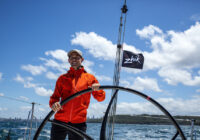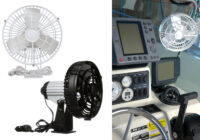By Danny Casey – Part 2
CAN BATTERIES DELIVER?
With the headlong rush of automotive manufacturers to embrace electrical motive power, one might think that the future has already been predetermined and mapped out – but this is not so. Whilst I know (or think I know!) a not unreasonable amount about engines of the internal combustion variety, I would be the first to admit that my knowledge of new-technology electric motors and drive systems is, at best, patchy, limited and, at worst, coloured with a fair degree of wary scepticism.
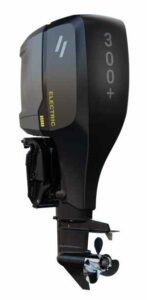
Evoy recently released a
300hp electric outboard.
Leaving aside for a moment the huge global footprint and wanton damage to the earth’s surface which will result from the large-scale mining necessary to rip from the ground the precious metals (cobalt, lithium, nickel, manganese, graphite) required to make suitable batteries, it must also be borne in mind that clean air, like clean anything, comes at a price (literally a dollar value). Even the most ardent and fervid pro-EV lobbyists in Europe are now beginning to realise that every EV needs a reliable charger; that every charger needs a reliable and cheap power supply, and that such a power supply can only be generated by power stations. And the best, most effective, most reliable and most economical power stations are all powered by – wait for it – coal! In what is one of the most ironic dichotomies ever, so committed are the Germans, for example, to EVs, that they have had to recommission at least a dozen coal-fired power stations which had been mothballed – it’s the only way to guarantee a reliable electricity supply. Granted Putin’s antics may have done more than a little to prompt this, but the Germans know that if the supply of electricity stops, then their industries, their daily lives and their EVs will grind to a halt. Another German company, other than Volkswagen, which has enthusiastically and proactively embraced the potential of electric power is the diesel engine company, Deutz, which has owned Torqeedo, the electric outboard manufacturer, since late 2017.
Of all the current and mooted manufacturers of electric outboards, I feel that Torqeedo – due to the financial backing of Deutz and the head-start it has had in the sphere – is probably the one I’d tip for greatest success. I don’t know how practicable or viable a high-output electric motor from Torqeedo or anyone else would be (elaboration on this later), but there is a huge, ready-made, existing market for the mainly portable units currently produced by Torqeedo.
As outlined in a previous article, I feel that Torqeedo will undoubtedly start to capture market share in the light portable 2-15 hp segment – particularly if all that is needed is a motor to push a tender a short distance from a jetty or beach to a large boat. In such a case, electric would be an intelligent, logical and conscientious choice.
If short runs are all an owner envisages, then why bother with filling a fuel tank or opening a fuel tap, then setting a throttle to the “start” position before finally pulling the starting cord? Not to mention that a portable electric outboard can be stored safely in the lazarette of a yacht or launch with no fear of dangerous fuel vapour or spillage. And if one does indeed have the good fortune to be able to drop hundreds of thousands of dollars into a new flybridge cruiser, launch or trawler yacht, and if one wishes to display and propagate an environmental conscience to soothe one’s guilt, then an electric outboard makes a strong statement.
Once Torqeedo starts to attract viable competitors, and the prices of lithium-ion batteries (and the outboards with which they are equipped) eventually correct downward, then there is little doubt that every single one of the major internal-combustion outboard manufacturers will start to see an inexorable encroachment into their portable segment – however, the only way this will ever be known for certain is if/when the importers of electric outboards start to supply their monthly figures to the industry statistics body. The matter of high-output electric outboards is a different, complex and fraught subject. Such a concept is possible, and has indeed been executed quite well, but all projects so far have involved the purchase of a conventional outboard motor, the discarding of its internal combustion power unit, and the installation of an electric motor in place of the ICE. In August 2022, the American racer, Shaun Torrente, set a world record of 109 MPH in a catamaran powered by two Vision E-Motion electric outboards – which appeared to have been derived from the new 115/140 hp Tohatsu.
But this is where I have to plead ignorance on the whole creation and set-up of boats with lithium-ion power. How big are the batteries? How bulky or heavy are they? Where do the batteries go? Do they go under the floor instead of the fuel tank? Are they bonded/sandwiched into the floor? Or does the outer case of the batteries actually double as the floor of the boat? Also, in addition to the motive batteries (most likely lithiumion or a derivative thereof), will the boat still require conventional leadacid or AGM (Absorbent Glass Mat) batteries to power the electronics, nav lights, bilge pump and radio etc.? If such conventional batteries are still required, how would they be charged? I would also want my fears addressed on what would happen if the boat started to take on water and sink. Would the occupants receive an electric shock? Would marine life in the water close to the sinking boat receive an electric shock? Would the occupants of any aluminium boats nearby receive an electric shock? Currently too many variables, unknowns and issues of concern, I feel…
I also think that for high-output electric outboards, a large degree of cooperative synergy and shared collaboration will undoubtedly be required between the engine supplier and the boat builder. Such projects would therefore need to be comprehensive, intertwined joint ventures – there is no way a boat can be easily fitted with a large electric outboard in the same way as any ICE outboard can be chosen and conveniently installed. For this reason, I think it’d be a brave boatbuilder who would go all-in with a fledgling, neophyte electric outboard manufacturer to develop a unitary ready-to-go product. In short, then, whilst the portable segment may see some seismic shifts in the not-too-distant future, I can’t see the main players being overly worried about these start-ups offering alternative power sources for highspeed or offshore boating. Weight, incorporation/integration of the boat and motor and offshore “range anxiety” (a heart-palpitating condition familiar to every EV user) should keep the ICE outboard a strong player for many years to come.
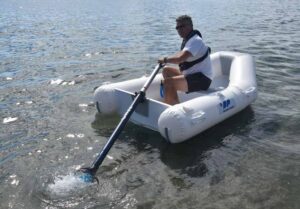
Temo’s electric outboard drive and battery is all combined on one long shaft.
CAN HYDROGEN HELP?
In the frenzied clamour towards electrical motive power, one automotive name (the biggest automotive name of all, in fact) is glaringly low-key and maybe even absent – Toyota. Some international automotive pundits and diehard EV proponents have collectively opined that Toyota is dragging its heels, has missed the boat, and will be a follower rather than a leader in the electrification of the automobile. But to that I say one thing: anyone who writes off or dismisses Toyota’s direction and policies is a fool. Toyota has always been, and remains, the prime advocate for hybrids (i.e. ICE and electric engines in synergy) and the Prius and Camry are sterling examples of its resounding success in this sphere. And whilst Toyota is certainly not against total electrification (and will have no commercial alternative other than to enter the sector), it emphatically believes that the ICE can be cleaned up to the point that it will have no environmental impact at all as it operates. Naturally this cannot be done with relatively dirty fuels like diesel or gasoline, as combustion, no matter how clean or “neutered” the engine, will result in toxic emissions.
It could, however, be done with hydrogen and, to this end, Toyota is just one of several manufacturers (Suzuki and Subaru are the other two in Japan and Hyundai/Kia is the main proponent in South Korea) carrying out research on hydrogen fuel cells. At first glance, hydrogen is an ideal fuel source. It has a high energy content and is extremely clean – emitting only “pure” water from a vehicle’s tailpipe that is theoretically clean enough to drink. Drawbacks, however, are that despite having a high energy content, the energy per unit volume is low in comparison with liquid fuels. Therefore, hydrogen must be greatly compressed and pressurised, and liquefied to such an extent that the tank or reservoir holding the hydrogen has to be much heavier than the weight of hydrogen held therein. This pressurised storage (which can cause leakage), coupled with low-ignition and high-combustion energy, means there is always the imminent risk of a severe explosion (just think of the Hindenburg airship). Until the issues with the reliable storage and delivery of hydrogen are resolved, it won’t be a mainstream power source in the near future (it will happen sooner or later, though), but as the three Japanese companies – Toyota, Suzuki and Subaru – are reportedly engaged in this research collectively, there will undoubtedly and eventually be a niche for hydrogen-powered vehicles. But as a fuel for outboards? Not as long as I’m alive.
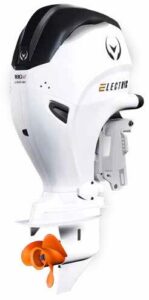
Vision Marine’s Peak 180E motor can provide a consistent 180 HP of pure electric power.
WHY NOT STICK WITH WHAT WE HAVE?
As an industry, the outboard motor sector is much, much too small to innovate, develop and see through to fruition alternatively-fuelled or alternatively-powered units. If we take, as just two automotive examples, Subaru and Mazda, these companies are classified as lowish-volume automobile manufactures but still each one produces close to 1.5 million vehicles per annum. To put that into perspective, each of those companies manufactures more units singly than are produced by all manufacturers in the entire outboard industry – the total world market for outboards is just over 850,000 units per annum. Although currently unlikely, it is not beyond the bounds of possibility that the three Japanese companies who also manufacture automotive engines (Honda, Suzuki and Yamaha) could eventually “trickle down” some EV or hybrid automotive to their outboard lines, but if so, that would not happen until there is a directive for them to so do – after all, why would one unnecessarily and expensively address an issue which one had not yet been asked to address? The reality is that in terms of damage to the environment, a modern 4-cycle outboard is as efficient, environmentally-friendly and clean as it is possible to be. The “pollution” emitting from outboards is but a drop in the ocean in comparison with the diesel and heavy oil being consumed by, and leaking from, commercial vessels worldwide.
Other than further development and reworking of the current ICE outboard platforms, I can’t honestly see the industry as a whole investing in the creation of completely new models (there is too much international uncertainty in all spheres, for one thing), but I would expect to see current model/derivative gaps in everyone’s ranges plugged and horsepower outputs taken as high as they can go within current platform constraints. If one were to examine the supposed pollution (noxious and aural) caused by boating, it would pale into insignificance in comparison with what is emitted relatively, scale-wise and percentagewise, from the likes of chainsaws, whipper-snippers and other power equipment. The outboard industry has progressively and proactively shown the environment enormous respect – it has, after all, virtually and voluntarily killed the 2-stroke – but I would suggest that it is not beyond the realms of possibility or current technology to further “clean up” all existing 4-strokes a little should such a change ever be mandated. It could possibly be that, lurking around the corner, there is a wholly revolutionary, ruthlessly efficient, environmentally friendly and viable product that will create an entirely new standard and genre but it’d take some doing to better the integrity and environmental empathy built into what we are using today. I can honestly say, therefore, that I can see no reason why my kids will not be able to confidently, enthusiastically and conscionably purchase an ICE outboard motor to pursue their own boating dreams.
Danny Casey is highly experienced, undoubtedly idiosyncratic, and immensely knowledgeable about things mechanical, new or old. His knowledge and passion are as a result of spending his whole life in or around anything power-driven – especially marine engines. His passion for boating is second to none, with his life a montage of fabulous memories from decades spent in or around water and boats, both here and in Europe. Danny has spent myriad years in the recreational marine industry in a varied career in which he has bamboozled colleagues and competitors alike with his well-honed insight.

His mellifluous Irish accent, however, has at times been known to become somewhat less intelligible in occasional attempts at deliberate vagueness or when trying to prevent others from proffering a counter-argument or even getting a word in. Frank and to-the-point, but with a heart of gold, it can be hard to convince Danny to put pen to paper to share his knowledge. Marine Business News is grateful for his contributions. Connect with Danny through LinkedIn.







